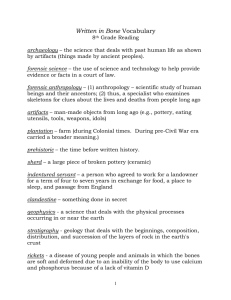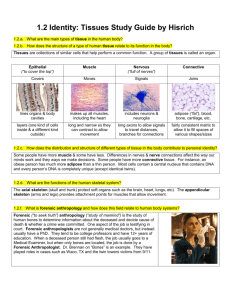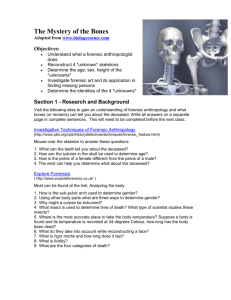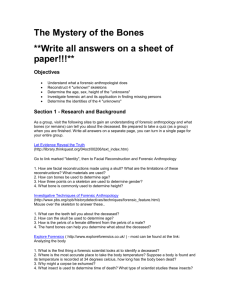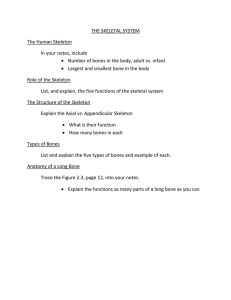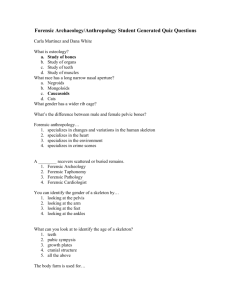Forensic Anthropology
advertisement
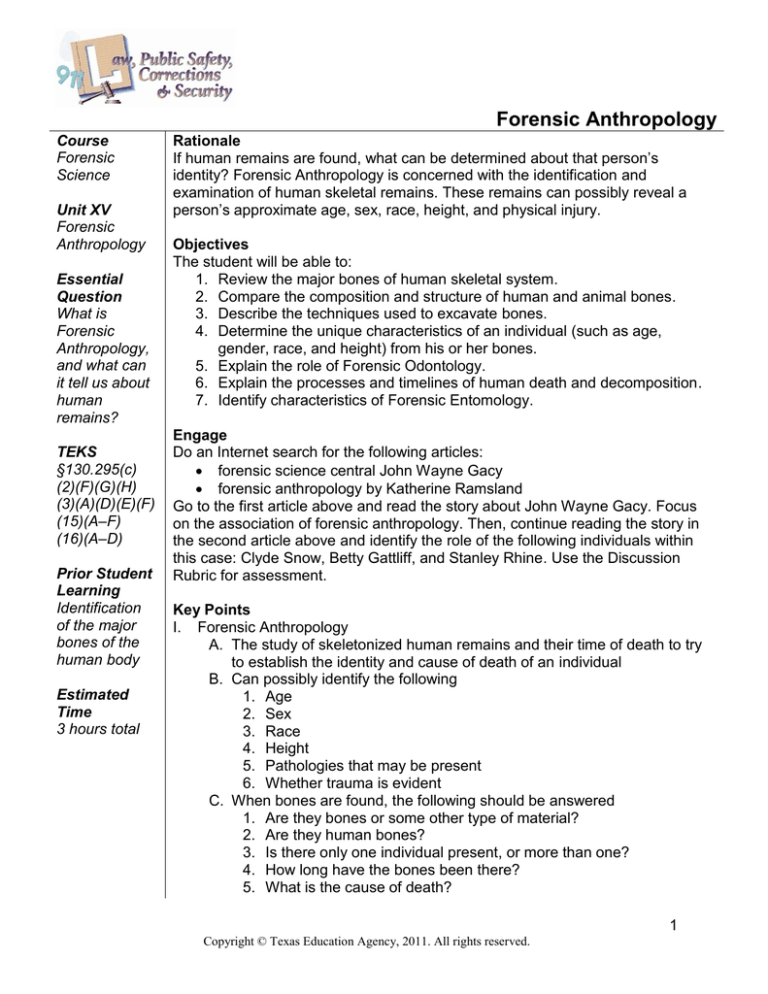
Forensic Anthropology Course Forensic Science Unit XV Forensic Anthropology Essential Question What is Forensic Anthropology, and what can it tell us about human remains? TEKS §130.295(c) (2)(F)(G)(H) (3)(A)(D)(E)(F) (15)(A–F) (16)(A–D) Prior Student Learning Identification of the major bones of the human body Estimated Time 3 hours total Rationale If human remains are found, what can be determined about that person’s identity? Forensic Anthropology is concerned with the identification and examination of human skeletal remains. These remains can possibly reveal a person’s approximate age, sex, race, height, and physical injury. Objectives The student will be able to: 1. Review the major bones of human skeletal system. 2. Compare the composition and structure of human and animal bones. 3. Describe the techniques used to excavate bones. 4. Determine the unique characteristics of an individual (such as age, gender, race, and height) from his or her bones. 5. Explain the role of Forensic Odontology. 6. Explain the processes and timelines of human death and decomposition. 7. Identify characteristics of Forensic Entomology. Engage Do an Internet search for the following articles: forensic science central John Wayne Gacy forensic anthropology by Katherine Ramsland Go to the first article above and read the story about John Wayne Gacy. Focus on the association of forensic anthropology. Then, continue reading the story in the second article above and identify the role of the following individuals within this case: Clyde Snow, Betty Gattliff, and Stanley Rhine. Use the Discussion Rubric for assessment. Key Points I. Forensic Anthropology A. The study of skeletonized human remains and their time of death to try to establish the identity and cause of death of an individual B. Can possibly identify the following 1. Age 2. Sex 3. Race 4. Height 5. Pathologies that may be present 6. Whether trauma is evident C. When bones are found, the following should be answered 1. Are they bones or some other type of material? 2. Are they human bones? 3. Is there only one individual present, or more than one? 4. How long have the bones been there? 5. What is the cause of death? 1 Copyright © Texas Education Agency, 2011. All rights reserved. 6. Who is this? D. Age Determination 1. Sutures a) Zigzag-like cracks appearing on the skull b) Separated at birth, and gradually close from the inside out c) The older the individual, the less visible sutures 2. In toddlers and infants, length of the long bones is measured and compared to known growth curves 3. After age 21, age is estimated by the level of change on the surfaces of the bones E. Gender Determination 1. Males a) Narrow pelvic opening b) Long, narrow sacrum c) Acute (less than 90o) subpubic angle d) Overall larger skull e) Pronounced brow bone f) Overall robust skeleton 2. Females a) Larger, circular pelvic opening b) Wide sacrum c) Wide subpubic angle (approximately 90o) d) Smaller skull e) Diminished brow bone f) Overall slender skeleton F. Race Determination 1. Most commonly divided into 3 categories a) Mongoloid (Asian or Native descent) (1) Flat or projected outward frontal plane (2) Small, rounded nasal cavities (3) Circular eye orbits b) Caucasoid (European) (1) Flat cranium (2) Long, narrow nasal cavities (3) Oval eye orbits c) Negroid (African) (1) Cranium projected outward (2) Wide nasal cavity (3) Square eye orbits G. Height Determination 1. Determined by measuring the long bones and calculating from known equations 2. The equations are different based on the bone, the race of the individual, and the gender 3. The long bones used are the femur, radius, tibia, and humerus H. Other Determining Factors 1. A forensic anthropologist or sculptor may create facial reconstructions from skulls to help identify skeletal remains 2 Copyright © Texas Education Agency, 2011. All rights reserved. 2. Pathological identities such as past surgeries and broken bones that show healing and/or scarring 3. Trauma may be studied by observing cracks, holes, or tool marks on the bones II. Excavation of Skeletal Remains A. These are the guidelines provided to expose and recover remains in order to minimize their damage B. Guidelines will differ based on scene conditions C. The steps 1. Remove litter and vegetation if present 2. Stake out and map the exact excavation area 3. Determine the grave outline and remove the soil covering; sift each layer to check for evidence or small bones 4. Work in horizontal layers 5. As work continues, document with photography, maps, inventory, and measurements 6. Once all remains have been exposed, document again 7. Remove each bone separately and bag it individually III. Forensic Odontology A. The study of teeth for body identification 1. Can estimate age by observing deciduous teeth in children and wear patterns in older adults 2. Can be compared to dental records 3. May contain DNA 4. Teeth are harder to destroy in a fire than are bones 5. Can be used with bite mark identification IV. Human Death A. If death has occurred, the following must be determined 1. Cause a) The disease or injury responsible for initiating the sequence of events that resulted in death b) Examples (1) Gunshot wound (2) Drug overdose (3) Cardiovascular disease 2. Manner a) The “reason” the cause of death occurred b) Examples (1) Accidental (2) Homicidal (3) Natural (4) Suicidal (5) Undetermined 3. Mechanism a) The immediate physiological derangement resulting in death 3 Copyright © Texas Education Agency, 2011. All rights reserved. b) Examples (1) Hemorrhage (2) Cardiac arrhythmia B. Stages of Decomposition 1. Fresh a) Immediately after death b) Blood is not pumping, so it drains and pools to the lower parts creating livor mortis, or lividity c) Rigor mortis, the stiffening of the muscles, can also be seen 2. Bloat a) When anaerobic metabolism causes gases to build up, making a body swell or bloat b) Can cause fluids to leak or “purge” from orifices 3. Active decay a) The greatest body mass loss b) Most of the tissue is liquefied, and strong odors persist c) Much of the maggot mass pupates 4. Advanced decay a) Little insect activity b) Bones are revealed 5. Dry remains a) All that remains are dry skin, cartilage, and bones, either partially or fully skeletonized V. Forensic Entomology A. The study of insects and their life cycles to determine how long a body has been deceased B. When a dead body is present, necrophilious insects, or insects that feed on dead tissue, will usually infest a body within 24 hours C. The first and most commonly found insect is the blow fly D. Other insects include 1. Flies in different stages of the lifecycle, including eggs, larvae, pupae, and adults 2. Several types of beetles that can either be necrophilious or predatory on other insects 3. Predator insects that prey on necrophilious insects 4. Omnivorous insects, such as ants and wasps, that might feed on the body itself, other insects, or the surrounding vegetation 5. Indigenous insects and/or spiders, might be present, but their presence is usually coincidental to the location of the body E. The timeframe for lifecycle development is influenced by environmental conditions such as 1. Climate 2. Weather 3. Geographical location 4. Drugs and/or toxins present in the body Activities 4 Copyright © Texas Education Agency, 2011. All rights reserved. 1. Bone Quiz. Have students complete the Bone Quiz (this allows students an opportunity to review their knowledge of the locations of the major bones). Use the Bone Quiz Key for assessment. 2. Who is the Skeleton in the Closet? – Human Anthropology Lab. Have students observe the differences between various characteristics of bones, including race, gender, height, and age. Use the Human Anthropology Lab handouts. Note: For this activity, you can use either an articulated skeleton or disarticulated bones. Having a separate skull, femur, humerus, and pelvic girdle helps with measurement. The information and activity in this assignment provide the basics needed to fulfill this objective. However, the level of difficulty can be increased by adding more calculations and observations, such as measuring subpubic angles with a protractor or using calipers for measurement. There are no set answers to the data tables and questions above because different bones are provided in the lab. However, there should be right/wrong answers based on the bones a student has, so the instructor will have to go through the lab first and observe/calculate the answers. 3. One Bite Out of Crime – Forensic Odontology Lab. Have students explore odontology by studying teeth and bite marks. Divide the class into two groups. After the students bite their cups, pick someone to be the suspect. Mark the two blank bites as “Crime Scene.” Throw away all other blank bite marks. Give one Crime Scene bite mark and one of each of the remaining suspects to each of the groups. (See the lab handouts for more details.) Use the Forensic Odontology Lab Handouts for the activity and the Forensic Odontology Lab Key for assessment. 4. Forensic Entomology Lab. Have students observe the various stages of a fly’s life cycle on decomposing flesh. Use the Forensic Entomology Lab handouts and the Forensic Entomology Lab Key for assessment. Note: Make sure you complete a “Crime Scene Sample” ahead of time and document how many days it has been there. Students will compare the appearance and insects found with their daily observations to conclude how long the crime scene has been present. For the plastic containers, make sure holes in lids allow for ventilation, but not for other insects to intrude (or possible escape). Relatively nice weather is important. Stay away from excessive wind and cold temperatures if possible. Also, make sure nothing is able to “steal” the corpses. When placing the containers outside to sit, 30–40 minutes is usually adequate. Assessments Forensic Anthropology Exam and Key Bone Quiz and Key 5 Copyright © Texas Education Agency, 2011. All rights reserved. Forensic Entomology Lab Key Forensic Odontology Lab Key Bone Crossword Puzzle Key Discussion Rubric Materials Forensic Anthropology computer-based presentation Bone Crossword Puzzle Human Anthropology Lab Handouts Bones Measuring tape/ruler Calculator Forensic Odontology Lab Handouts 2 foam cups Gloves Stereoscopic microscope or magnifying glass (if needed) Forensic Entomology Lab Forensic Entomology Lab Key Chicken or beef liver (cut up) Plastic containers with ventilated lids Magnifying glass or stereoscopic microscope with petri dish Forceps Bone Review Crossword Puzzle and Key X-rays of a human skeleton Resources Saferstein, Richard. Forensic Science: An Introduction. New Jersey: Pearson Prentice Hall, 2008 Saferstein, Richard. Forensic Science: An Introduction. 2nd ed. New Jersey: Pearson Prentice Hall, 2011 Saferstein, Richard. Criminalistics: An Introduction to Forensic Science. 8th ed. Upper Saddle River, NJ; Pearson Prentice Hall, 2004 Do an Internet search for the following articles: forensic science central John Wayne Gacy forensic anthropology by Katherine Ramsland Accommodations for Learning Differences For reinforcement, students will complete the Bone Review Crossword Puzzle. Use the Bone Review Crossword Puzzle Key for assessment. For enrichment, students will review the names of bones and their locations by creating a life-size skeleton. Obtain several x-ray films from a local doctor’s office, hospital, etc. Trim them, leaving only the images of the bones, and separate bones of clusters such as ribs, vertebrae, bones of the hands, bones of the feet, etc. Have students divide into small groups. For each group, on a large 6 Copyright © Texas Education Agency, 2011. All rights reserved. piece of butcher paper, have the students outline someone’s body in the correct anatomical position (matching the x-ray). Students will receive a stack of x-ray films and must identify the bones and place them on the body in the correct location. Next, the groups will “tour” the other bodies to check for accuracy. Use the Discussion Rubric for assessment. State Education Standards Texas Essential Knowledge and Skills for Career and Technical Education §130.295. Forensic Science (One Credit). (2) The student uses scientific methods and equipment during laboratory and field investigations. The student is expected to: (F) collect and organize qualitative and quantitative data and make measurements with accuracy and precision using tools such as calculators, spreadsheet software, datacollecting probes, computers, standard laboratory glassware, microscopes, various prepared slides, stereoscopes, metric rulers, electronic balances, gel electrophoresis apparatuses, micropipettors, hand lenses, Celsius thermometers, hot plates, lab notebooks or journals, timing devices, cameras, Petri dishes, lab incubators, meter sticks, and models, diagrams, or samples of biological specimens or structures; (G) analyze, evaluate, make inferences, and predict trends from data; and (H) communicate valid conclusions supported by the data through methods such as lab reports, labeled drawings, graphic organizers, journals, summaries, oral reports, and technology-based reports. (3) The student uses critical thinking, scientific reasoning, and problem solving to make informed decisions within and outside the classroom. The student is expected to: (A) in all fields of science, analyze, evaluate, and critique scientific explanations by using empirical evidence, logical reasoning, and experimental and observational testing, including examining all sides of scientific evidence of those scientific explanations, so as to encourage critical thinking by the student; (D) evaluate the impact of scientific research on society and the environment; (E) evaluate models according to their limitations in representing biological objects or events; and (F) research and describe the history of science and contributions of scientists. (15) The student explores principles of anthropology relevant to forensic science. The student is expected to: (A) identify the major bones of the human skeletal system; (B) compare composition and structure of human bones with other animals; 7 Copyright © Texas Education Agency, 2011. All rights reserved. (C) (16) describe the techniques used to excavate bones from a crime scene; (D) determine unique characteristics of the human skeletal system such as gender and age; (E) explain the role of dental records in identification of remains; and (F) describe the role of dental matching in forensic science. The student calculates the time and cause of death in relationship to decomposition of the human body. The student is expected to: (A) explain the process and timeline of rigor mortis and its role in calculating time of death; (B) explain post mortem lividity and its importance when processing a crime scene; (C) determine time of death using entomology; and (D) determine time and cause of death through case studies. College and Career Readiness Standards Science Standards I. Nature of Science: Scientific Ways of Learning and Thinking C. Collaborative and safe working practices 1. Collaborate on joint projects. 2. Understand and apply safe procedures in the laboratory and field, including chemical, electrical, and fire safety and safe handling of live or preserved organisms. 3. Demonstrate skill in the safe use of a wide variety of apparatuses, equipment, techniques, and procedures. 8 Copyright © Texas Education Agency, 2011. All rights reserved. Name___________________________________________ Date__________________ Forensic Anthropology Exam ______1. Which condition causes the body to go stiff after a certain amount of time? a) Algor mortis b) Rigor mortis c) Livor mortis ______2. External factors play a role in decomposition. Which of the following places would speed up this process? a) Inside a house b) In the Arctic c) In a desert d) In a rainforest ______3. Which of the following is most likely to be the first found on a dead body? a) Mosquito b) Wasp c) Ladybug d) Blow fly ______4. Which of the following is the best way to identify remains that are decomposing? a) Dental records b) Hair color c) Fingerprints d) Tattoos ______5. Which of the following is NOT a progressive level of decomposition? a) Fresh b) Decay c) Wet d) Bloat ______6. Which condition causes a purplish-red color on the skin after death? a) Algor mortis b) Rigor mortis c) Livor morits 9 Copyright © Texas Education Agency, 2011. All rights reserved. ______7. What can forensic entomology be used to determine? a) Estimated time of death b) Location of death c) Location of wounds on the body d) All of the above ______8. Which of the following represents the best measure available for estimating the time of death (especially within the first 18 hours after death)? a) Changes in body temperature b) Rigor mortis c) Cloudiness of the eyes d) Coloration of the body ______9. Forensic odontology involves the study of a) Bones b) Teeth c) Drugs d) Insects _____10. The rate of cooling of a dead body can be influenced by all but the a) Size of the body b) Gender of victim c) Location d) Exposure to direct sunlight _____11. Which of the following is not a manner of death? a) Drowning b) Natural c) Suicide d) Homicide _____12. A 63-year-old male dies of a severe gunshot wound to his chest. This describes his a) Cause of death b) Manner of death c) Mechanism of death _____13. In the example above, severe/fatal bleeding would be the a) Cause of death b) Manner of death c) Mechanism of death _____14. In the event the wound was self-inflicted, suicide would be the a) Cause of death b) Manner of death c) Mechanism of death 10 Copyright © Texas Education Agency, 2011. All rights reserved. _____15. A skull with a frontal plane that is flat or projected outward, with small, rounded nasal cavities and circular eye orbits would be a) Mongoloid (Asian) b) Caucasoid (Caucasian) c) Negroid (African) _____16. __________ have a narrow pelvic opening, a long narrow sacrum, and a larger skull. a) Males b) Females _____17. Approximate age determination can be done by observing a) Sutures b) Wear and tear on teeth c) Ends of bones d) All of the above _____18. __________ can be determined by measuring specific long bones and calculating from known equations. a) Race b) Gender c) Height d) Age _____19. When studying remains, a forensic anthropologist may be able to identify which of the following? a) Trauma b) Past surgeries c) Past diseases/pathologies d) All of the above 11 Copyright © Texas Education Agency, 2011. All rights reserved. Forensic Anthropology Exam Key 1. B 2. D 3. D 4. A 5. C 6. C 7. D 8. A 9. B 10. B 11. A 12. A 13. C 14. B 15. A 16. A 17. D 18. C 19. D 12 Copyright © Texas Education Agency, 2011. All rights reserved. Name___________________________________________ Date__________________ Bone Quiz Rationale: The purpose of this activity is to review the locations of the major bones. Directions: As you read the scenario, fill in the blanks with the appropriate location of the body. I should have known it was going to be one of those days. My alarm had been acting funny lately. It was blaring so I rolled out of bed. With my eyes barely open, I stubbed my (1) PHALANGE on the bedpost. I began hopping on one (2) METATARSALS/ TARSALS, lost my balance, and bumped my (3) ZYGOMATIC PROCESS on the door to the bathroom. With pain in my lower extremity, I thought a warm shower would make me feel better. As I stepped in, I slipped and fell onto my left shoulder shouting “Oh no, I think I broke my (4) CLAVICLE.” I crawled on my (5) METACARPALS/CARPALS and (6) PATELLAS toward my phone to call for help and felt my (7) CRANIUM begin to ache. I used my right (8) PHALANGES to call my friend and she answered with a very loud scream. My (9) MANDIBLE dropped when she told me what had just happened to her. She said she was so startled to receive a call at that time of night, she bumped her (10) TIBIA on the chair trying to get to her phone. I could have died when she told me it was only 2 in the morning. With bruises, aches, and possible broken bones, I decided it was best to take some aspirin and go back to bed until morning. I should have known. 1.____________________________________ 2.____________________________________ 3.____________________________________ 4.____________________________________ 5.____________________________________ 6.____________________________________ 7.____________________________________ 8.____________________________________ 9.____________________________________ 10.___________________________________ 13 Copyright © Texas Education Agency, 2011. All rights reserved. Bone Quiz Key 1. Toes 2. Foot 3. Cheek 4. Collarbone 5. Hands 6. Knees 7. Head 8. Fingers 9. Jaw 10. Shinbone 14 Copyright © Texas Education Agency, 2011. All rights reserved. Name________________________________ Date______________________ Who Is The Skeleton In The Closet? Forensic Anthropology – Human Skeleton Lab Rationale: Through measurements, observations, and comparison, this lab allows students to determine unique characteristics of a human skeleton, such as height, gender, age, and race. Materials: Various bones Measuring tape or ruler Calculator Part 1: Gender Determination Observe the skull and pelvis and record your results in Data Table 1. DATA TABLE 1: GENDER DETERMINATION Feature Female Male Cranium Medium to Large Large Forehead High, vaulted, and rounded Low, and sloped backward Brow bone Diminished Pronounced Mastoid process Diminished or absent Pronounced Mandible angle Obtuse (>900) Approximately right (~900) Pelvis opening Wide, circular Narrow, noncircular Sacrum Short, wide, and turned outward Width/length almost equal, turned inward Subpubic angle Approximately right (~900) Acute (<900) Overall skeleton (if available) Slender Robust “Closet Skeleton” 15 Copyright © Texas Education Agency, 2011. All rights reserved. Part 2: Age Determination The following data will give you a range of ages. Compare your skull to the characteristics listed. If a complete skeleton is available, complete this. Otherwise, leave the bottom section blank. DATA TABLE 2: AGE DETERMINATION Age Skeletal Characteristic 21–30 Lambdoidal suture (rear of cranium) fused 30–32 Sagittal suture (center of cranium) fused 48–50 Coronal suture (front of cranium) fused 4–6 Humerus head bones fused 10 Finger bones fused 18–24 Sternum fused to clavicle 24–30 Sacrum bones fused “Closet Skeleton” Approx. Age Age Characteristics 16 Copyright © Texas Education Agency, 2011. All rights reserved. Part 3: Race Determination Observe the skull and compare the characteristics in Data Table 3. DATA TABLE 3: RACE DETERMINATION Caucasoid Mongoloid Negroid Eye Orbitals Oval Circular Square Nasal cavity Long, narrow Small, rounded Wide Cranium frontal plane Flat Flat or projected outward Projected outward “Closet skeleton” Part 4: Height Determination To determine the height of an individual, measure the length of the humerus and femur, and plug the measurements into the equation. Caucasoid and Negroid have different equations, but the equation listed in the table below is for unknown ancestry. Make sure you have already determined gender. Convert height in centimeters (cm) to feet/inches. (2.54cm = 1 inch). DATA TABLE 4: HEIGHT DETERMINATION Male Female Humerus Height (cm) = humerus length (cm) X 4.62 + 19.00 Height (cm) = humerus length (cm) X 4.62 + 19.00 Femur Height (cm) = femur length (cm) X 2.71 + 45.86 Height (cm) = femur length (cm) X 3.01 + 32.52 “Closet skeleton”: Humerus length (cm) = ________________ Femur length (cm) = ________________ Calculated height from humerus = ____________(cm) Calculated height from femur = ___________(cm) “Closet skeleton” height = _____________________________(ft/in) 17 Copyright © Texas Education Agency, 2011. All rights reserved. Part 5: Final Determinations of the “Closet skeleton” Gender:___________________________________________________ Approximate age:___________________________________________ Race:_____________________________________________________ Height:____________________________________________________ In your opinion, what was the easiest to determine? Why? __________________________________________________________________________ __________________________________________________________________________ __________________________________________________________________________ __________________________________________________________________________ __________________________________________________________________________ What was most difficult? Why? __________________________________________________________________________ __________________________________________________________________________ __________________________________________________________________________ __________________________________________________________________________ __________________________________________________________________________ What other characteristics can be used to identify remains? __________________________________________________________________________ __________________________________________________________________________ __________________________________________________________________________ __________________________________________________________________________ __________________________________________________________________________ 18 Copyright © Texas Education Agency, 2011. All rights reserved. Name_________________________________________ Date_______________________ One Bite Out of Crime Forensic Odontology Lab Rationale: In this activity, students will be able to explore the world of forensic odontology, the study of teeth and bite marks, to identify bodies and other aspects of certain crimes, by solving a classroom “whodunit.” Students will observe the role of dental matching. Background: One afternoon, a teacher was about to enjoy a chocolate bar that he received as a gift. As he pulled back the wrapper, he noticed it already had a bite out of it. He knew the bar was intact before class, so he suspected someone in the room took a bite while he was in the hallway before the tardy bell. A copy of the bite mark was produced into a piece of foam for comparison. It is your job as a forensic odontologist to observe and compare various bite marks to conclude who took the bite. Materials: 2 foam cups Gloves Stereoscopic microscope or magnifying glass (if needed) Procedure: 1. Take a foam cup and divide it in half vertically. Repeat this for a second cup. ***For safety and cleanliness, always handle the foam cups with gloves. 2. Gently bite into the foam until you leave bite marks. Do not bite completely through. 3. Leave two samples blank and label each of the others with your initials. 4. Turn in all four “bite marks” to the teacher, who will set up the lab groups. 5. You will receive a sample labeled “Crime Scene” and one for each of the “suspects.” 6. Observe and compare the crime scene bite mark with the suspects, using magnification if needed. 7. Answer the following questions. 19 Copyright © Texas Education Agency, 2011. All rights reserved. Data: Sketch the Crime Scene bite marks for reference. Upper Teeth Lower Teeth Questions: 1. What is your conclusion for this activity? Who made the bite marks? Give 3 reasons to support your answer. 2. How can bite marks be used to solve crimes? 20 Copyright © Texas Education Agency, 2011. All rights reserved. 3. What types of crimes would be associated with bite marks? 4. Who has sharper teeth: young or old people? Why? 5. Can this help you determine the age of the person who made the bite marks? 6. What other distinguishing features are on teeth that can help identify? 21 Copyright © Texas Education Agency, 2011. All rights reserved. Forensic Odontology Lab Key 1. Answers will vary. Make sure you remember who belonged to the Crime Scene. 2. Bite marks are unique individuals, just like fingerprints. They can help identify a specific person. 3. Assault, sexual assault or rape, crimes involving children, etc. 4. Young people have sharper teeth because they have not “used” them as much as older people. Compare them to the “needle-sharp” teeth of puppies. 5. Yes, it can help determine at least an approximation of age. 6. Other features include chips, holes, fillings, crowns, etc. that can be evident on a bite mark. 22 Copyright © Texas Education Agency, 2011. All rights reserved. Name____________________________________Date________________________ Forensic Entomology Lab Rationale: This activity allows students to observe an insect’s life cycle on decomposing flesh. Materials/equipment needed: Chicken or beef liver (cut up) Plastic containers with ventilated lids Magnifying glass or stereoscopic microscope with petri dish Forceps Procedure: 1. Label your container with your class period and group number. 2. Obtain a piece of liver and put it in the container. Do not put on the lid. 3. Place the container outdoors and move away so flies can “find the corpse” and lay eggs on it. 4. After at least 30 minutes, return to the area and retrieve your container. 5. Cover it with the ventilated lid and store it in an area free from excessive draft or cold temperatures. 6. Observe and record what you see with the “Crime Scene Sample.” 7. Observe and record the data of your container daily for two weeks. Crime Scene Sample Observation ______________________________________________________________________ ______________________________________________________________________ ______________________________________________________________________ ______________________________________________________________________ 23 Copyright © Texas Education Agency, 2011. All rights reserved. Day Insect Found/Stage Appearance and Condition of the Corpse Odor Detected Other Characteristics (Location of Insects) 1 2 3 4 5 6 7 8 9 10 11 12 13 14 DATA TABLE FOR “CORPSE” OBSERVATION 1) Describe the observations that you expected to have with this activity. Anything unexpected? 2) What conditions could affect this data? 3) Approximately how many “days old” was the crime scene sample? How did you determine this? 24 Copyright © Texas Education Agency, 2011. All rights reserved. Forensic Entomology Lab Key 1) Answers will vary 2) Temperature, rainy conditions, excessive wind, other predators in the area 3) To be determined by the teacher. 25 Copyright © Texas Education Agency, 2011. All rights reserved. Name_______________________________________ Date__________________ Bone Review Crossword Puzzle Across 5. protect the lungs 8. shoulder blade 11. single upper leg bone 13. large vertebrae of lower back 14. very back of the skull 15. smaller bone of the lower leg 17. toes and fingers 18. support most of the weight of the foot 19. wrist bones Down 1. small vertebrae of the neck 2. kneecap 3. lower jaw bone 4. it's not funny when you hit this bone 6. breastbone 7. hip bones 9. collarbone 10. bone of the forehead of the skull 12. one of the lateral bones of the upper limb 16. upper bone of mouth/jaw 18. vertebrae of the chest area 26 Copyright © Texas Education Agency, 2011. All rights reserved. Bone Review Crossword Puzzle Key Across: 5. Ribs – protect the lungs 8. Scapula – shoulder blade 11. Femur – single upper leg bone 13. Lumbar – large vertebrae of lower back 14. Occipital – very back of the skull 15. Fibula – smaller bone of the lower leg 17. Phalanges – toes and fingers 18. Tarsals – support most of the weight of the foot 19. Carpals – wrist bones Down: 1. Cervical – small vertebrae of the neck 2. Patella – kneecap 3. Mandible – lower jaw bone 4. Humerus – it's not funny when you hit this bone 6. Sternum – breastbone 7. Oscoxa – hip bones 9. Clavicle – collarbone 10. Frontal – bone of the forehead of the skull 12. Radius – one of the lateral bones of the upper limb 16. Maxilla – upper bone of mouth/jaw 18. Thoracic – vertebrae of the chest area 27 Copyright © Texas Education Agency 2011. All rights reserved Name_______________________________________ Date_______________________________ Discussion Rubric Objectives 4 pts. Excellent 3 pts. Good 2 pts. Needs Some Improvement 1 pt. Needs Much Improvement N/A Pts. Participates in group discussion Encourages others to join the conversation Keeps the discussion progressing to achieve goals Shares thoughts actively while offering helpful recommendations to others Gives credit to others for their ideas Respects the opinions of others Involves others by asking questions or requesting input Expresses thoughts and ideas clearly and effectively Total Points (32 pts.) Comments: 28 Copyright © Texas Education Agency 2011. All rights reserved
